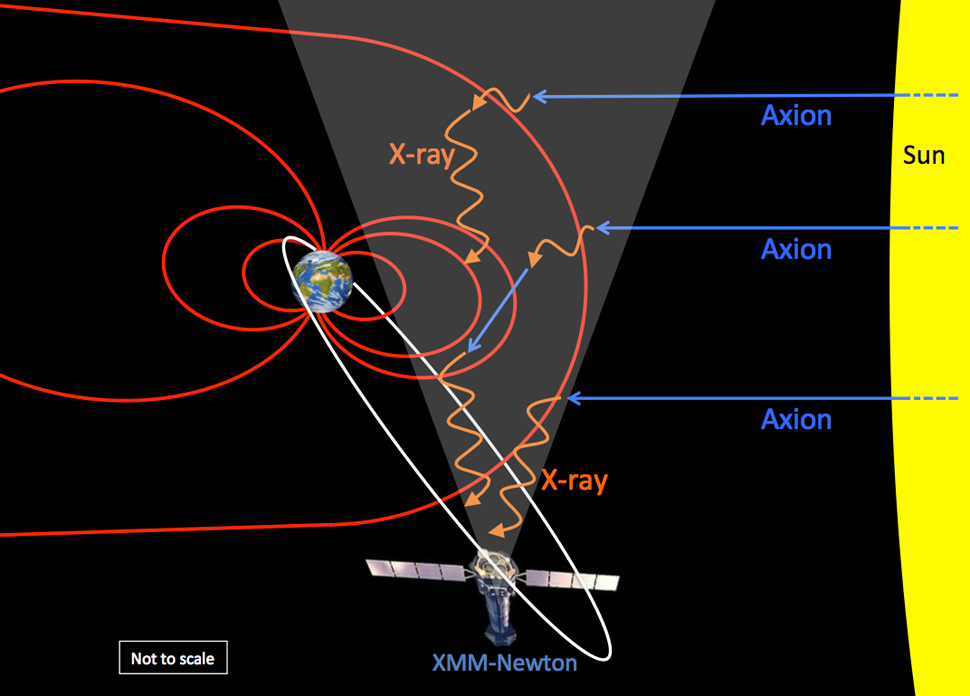Axions are captivating theoretical particles that hold the key to understanding dark matter, the mysterious substance that constitutes a significant portion of the universe’s mass. While these elusive particles have yet to be directly observed, researchers believe that confirming their existence could unlock answers to enduring questions in particle physics and the fundamental makeup of the cosmos. Recent advancements in the exploration of axion quasiparticles, as detailed in groundbreaking experiments, are paving the way for innovative technologies that integrate quantum principles and condensed-matter physics. By utilizing materials like manganese bismuth telluride, scientists can enhance their search for axions while simultaneously exploring their potential applications in quantum technologies. As the hunt for this dark matter candidate intensifies, the implications for both theoretical research and practical advancements in technology are immense.
The study of elusive elementary particles like axions could revolutionize our understanding of cosmic phenomena and bring clarity to the nature of dark matter. This research, often associated with the intricate world of quantum mechanics and particle dynamics, delves into the interactions and properties of potential axion quasiparticles, which are critical for developing advanced experimental techniques. Techniques in condensed-matter physics aim to harness materials such as manganese bismuth telluride to mimic and detect these hypothesized particles more effectively. The implications of this work not only touch upon crucial areas of physics but also spotlight the potential for transforming our technological landscape through insights gained from understanding dark matter dynamics. As researchers continue to push the boundaries of science, the intersection of particle physics and practical applications becomes ever more significant.
Understanding Axions and Their Role in Dark Matter
Axions are scalar particles theorized to solve the mystery of dark matter, which comprises approximately 85% of the universe’s mass yet remains undetectable by conventional means. These elusive particles were first proposed in the 1970s to address the strong CP (Charge Parity) problem in quantum chromodynamics. By positing the existence of axions, physicists aim to provide a framework that reconciles theories from particle physics with the observational data of cosmology. With axions as a leading candidate for dark matter, their discovery could fundamentally reshape our understanding of both the universe’s composition and the theoretical constructs of physics.
Recent advancements in experimental techniques have enhanced the prospects of axion detection, particularly through the use of axion quasiparticles. By utilizing sophisticated materials such as manganese bismuth telluride, researchers can create a conducive environment for simulating the effects of axion interactions. These quasiparticles represent an innovative way to explore the properties and behaviors of hypothetical axions, providing pathways to confirm their existence and uncover the complexities of dark matter interactions.
Manganese Bismuth Telluride: A Quantum Material for Axion Research
Manganese bismuth telluride is a compound renowned for its unique electronic and magnetic properties, making it an ideal candidate for advanced particle physics experiments. Researchers have been investigating this material’s capabilities for over half a decade, focusing on how its structure and characteristics can be manipulated at the atomic scale. The natural properties of manganese bismuth telluride allow it to support the creation of axion quasiparticles, opening doors to experimental setups that can better mimic the conditions necessary for axion detection.
The synthesis of manganese bismuth telluride involves nano-fabrication techniques that layer the material to minimize exposure to air, thus ensuring the preservation of its quantum features. Experimenters are now able to use this 2D crystal structure to explore axion dynamics with unprecedented precision. By studying these aggregates, scientists can start to isolate the interactions between dark matter axions and the underlying matter, paving the way for tools that could serve as efficient dark matter detectors.
The Intersection of Particle Physics and Quantum Technologies
The integration of particle physics and quantum technology represents a pivotal shift in how we approach fundamental questions about the universe. The research conducted by the team at Harvard and King’s College London exemplifies this synergy by employing advanced quantum materials, like manganese bismuth telluride, to explore the behavior of axion quasiparticles. These quasiparticles not only point towards potential pathways to detect dark matter but also offer insights into developing innovative technologies, such as improved measurement tools and quantum sensors.
The implications of such interdisciplinary research extend beyond the laboratory, potentially influencing sectors like telecommunications, materials science, and computing. By harnessing the fundamental principles of particle physics, scientists hope to create practical applications that exploit the properties of axions and their related quasiparticles, ultimately refining our technological capabilities while unraveling the mysteries of the universe.
Experimental Techniques Leading to Axion Discovery
Recent experimental advancements signify a monumental leap toward confirming axion existence amidst the dark matter enigma. Utilizing sophisticated ultrafast laser optics and measurement techniques, researchers can observe axion quasiparticles’ dynamics in real-time. This meticulous approach allows scientists to gauge the responses of these quasiparticles when interacting with potential dark matter axions, potentially unfolding new layers of physics that were once deemed purely theoretical.
The ongoing experiments not only verify theoretical models but also propel forward innovative detection methodologies. By tuning experimental conditions to resonate with specific frequencies expected from axions, researchers aim to create a landscape where the presence of dark matter signals can be isolated and confirmed. This precise tuning process marks a revolutionary development that underscores the commitment of the scientific community to decipher the cosmos’s most pressing mysteries.
The Impact of Axions on Cosmic Understanding
Axions could redefine our cosmic understanding by providing insights into the composition of the universe. As the most promising candidates for dark matter, understanding these particles can lead to significant breakthroughs in cosmological models and theories. The role that axions play in shaping the universe could illuminate our comprehension of structure formation, galaxy evolution, and the dynamics of cosmic expansion.
Moreover, confirming the existence of axions would validate theories in particle physics and provide a cohesive explanation for various phenomena observed in astrophysics. As researchers continuously refine their techniques and contribute to the burgeoning field of dark matter research, the implications of discovering axions extend far into the future of science, potentially leading to new paradigms in understanding both the minuscule and cosmic scales of existence.
Future Prospects of Axion Research
As innovative experiments continue to unveil the properties of axion quasiparticles, the horizon of axion research is brimming with potential. Researchers are not just focused on demonstrating the existence of axions but are eager to explore their unique characteristics and behavior under different conditions. Future endeavors will likely pivot towards creating highly sensitive detection methods that can capitalize on the elusive signatures of axion interactions.
With aspirations to develop the most accurate dark matter detector, scientists predict that the next 15 years could yield significant discoveries pertaining to dark matter and the broader universe. By advancing our methods of exploration and maintaining an interdisciplinary approach, researchers aim to create a better understanding of both axions and their potential to reshape our theoretical frameworks and technological advancements in the scientific landscape.
Interdisciplinary Approach to Axion Detection
The journey toward the discovery of axions highlights the necessity of an interdisciplinary approach that marries various scientific disciplines, such as condensed-matter physics, material chemistry, and high-energy physics. Collaborations across these fields engender a more holistic understanding of complex phenomena, allowing researchers to merge their expertise in innovative ways. This collaborative spirit is essential for tackling the challenges presented in axion detection and dark matter research.
The successful integration of these fields has enabled the development of advanced materials, measurement techniques, and theoretical models. As the scientific community further embraces this collaborative ethos, the prospects for unveiling the secrets of dark matter and particle physics will undoubtedly flourish, pushing the boundaries of what we perceive as possible.
Axion Quasiparticles as Tools for Detection
The use of axion quasiparticles as a detection mechanism marks a groundbreaking advancement in the quest to uncover dark matter. These quasiparticles serve as proxies, simulating the interactions that axions would have within a solid-state environment. The ability to measure the excitations of these quasiparticles opens new avenues for not only confirming the existence of dark matter but also understanding its nature and properties.
By employing axion quasiparticles in controlled experiments, researchers are aiming to develop a framework that could lead to swift detection of dark matter signals previously obscured by noise. The correlation between axion quasiparticles and their theoretical counterparts is a pivotal step, transforming abstract concepts into tangible results, and ushering in a new era of discovery in particle physics.
Technological Innovations Emerging from Axion Research
The exploration of axions and their quasiparticles holds great promise not only in the realm of fundamental science but also in the development of cutting-edge technologies. Innovations emerging from this research can lead to the creation of sophisticated sensors and measurement devices that capitalize on quantum phenomena. Such advancements may revolutionize various fields, including telecommunications, computing, and materials science.
By tapping into the unique properties of axion quasiparticles and their interactions, researchers are laying the groundwork for technologies we can barely imagine today. As these scientific endeavors culminate in both theoretical and practical breakthroughs, the ongoing research into axions has the potential to ripple through multiple disciplines, bridging gaps between theoretical physics and real-world applications.
Frequently Asked Questions
What are axions and why are they considered a candidate for dark matter?
Axions are hypothetical elementary particles proposed to solve some of the unresolved issues in particle physics, particularly regarding dark matter. They are theorized to be light and neutral, making them a possible component of the elusive dark matter believed to constitute about 85% of the universe’s total mass. Their unique properties could help explain the mystery of dark matter’s nature and behavior.
How are axion quasiparticles relevant to quantum technologies?
Axion quasiparticles serve as simulations of axion particles and can be utilized as detectors for actual axions. By leveraging their dynamics in experiments, researchers can explore new applications in quantum technologies, potentially leading to innovative advancements in fields such as quantum computing and advanced materials.
What role does manganese bismuth telluride play in axion research?
Manganese bismuth telluride is a critical material used in axion research due to its unique electronic and magnetic properties. By fabricating it into a 2D crystal structure, scientists create an ideal environment for nurturing axion quasiparticles, which can help in the quest for detecting dark matter.
How do researchers detect axion quasiparticles?
Researchers utilize advanced ultrafast laser optics and sophisticated measurement tools to observe the movements of axion quasiparticles in materials like manganese bismuth telluride. This allows them to confirm theoretical models and potentially detect interactions with dark matter axions.
Can axion quasiparticles be used as dark matter detectors?
Yes, axion quasiparticles have the potential to act as dark matter detectors. By measuring specific frequencies emitted during interactions with dark matter axions, scientists hope to create a highly sensitive detection system capable of identifying and studying dark matter more effectively.
What is the significance of confirming the existence of axions in particle physics?
Confirming the existence of axions would provide crucial insights into particle physics and cosmology, helping to explain the composition of the universe and the nature of dark matter. This could lead to significant advancements in our understanding of fundamental physics and the development of new technologies.
How do axions relate to the study of quantum materials?
Axions are related to quantum materials as their study can enhance our understanding of quantum phenomena. The exploration of axion quasiparticles within these materials exemplifies how quantum systems can lead to new discoveries in particle physics and could result in groundbreaking technological advancements.
Are there ongoing efforts to discover axions, and what do they involve?
Yes, there are ongoing research efforts aimed at discovering axions. These include experiments designed to investigate the properties of axion quasiparticles, refine experimental conditions, and tune detection methods to capture dark matter signals, which could lead to the eventual confirmation of axions as a fundamental particle.
What technological innovations could arise from axion research?
Research into axions could potentially lead to several technological innovations, including new forms of quantum technologies, advanced sensors for detecting dark matter, and novel optical applications through axion polaritons, enhancing both scientific understanding and practical applications in technology.
How is the interdisciplinary approach important in axion research?
The interdisciplinary approach is crucial in axion research as it combines various fields such as condensed-matter physics, material chemistry, and high-energy physics. This collaboration enriches scientific inquiry and promotes innovative methodologies essential for advancing research on axions and their implications.
| Key Points | Details |
|---|---|
| Existence of Axions | Axions are theoretical particles proposed to solve mysteries of dark matter and particle physics. |
| Significance of Research | Recent experiments offer methods to confirm the presence of axions, enhancing our understanding of the cosmos. |
| Experimental Findings | Researchers utilized quasiparticles and manganese bismuth telluride to study axion behavior, opening new technological pathways. |
| Interdisciplinary Approach | The project involved collaboration between physicists and chemists, integrating high-energy physics with materials science. |
| Future Directions | The team plans to further investigate axion quasiparticles, aiming to refine techniques for probing dark matter. |
Summary
Axions represent a promising solution to dark matter, a critical component of the universe’s mass that’s yet to be observed. This recent research not only underscores the theoretical underpinnings of axions but also illustrates the innovative methods being developed to search for them. As efforts continue to unravel the mysteries of dark matter, axions could play a pivotal role in enhancing our understanding of the fabric of the universe.










